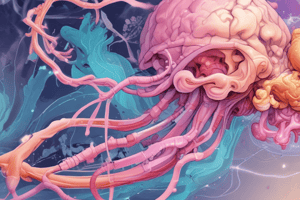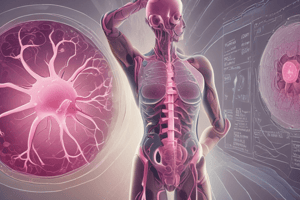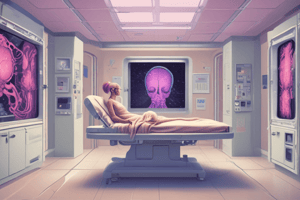Podcast
Questions and Answers
Which statement accurately differentiates between acute and chronic conditions?
Which statement accurately differentiates between acute and chronic conditions?
- Acute illnesses typically resolve within a short period, whereas chronic conditions persist for months to years. (correct)
- Acute illnesses always require ongoing treatment, but chronic conditions do not.
- Acute illnesses develop gradually over time, while chronic conditions arise suddenly.
- Chronic conditions are primarily caused by infectious agents, while acute illnesses stem from genetic factors.
A patient presents with a constellation of symptoms. Which of the following groups of symptoms is most indicative of a potential brain tumor?
A patient presents with a constellation of symptoms. Which of the following groups of symptoms is most indicative of a potential brain tumor?
- Intermittent chest pain, shortness of breath, and palpitations.
- Persistent morning headaches that subside after vomiting, vision and speech problems, and loss of appetite. (correct)
- Sudden weight gain, increased appetite, and elevated mood.
- Frequent urination, lower back pain, and blood in urine.
Which of the following statements best describes the fundamental difference between a benign and a malignant tumor?
Which of the following statements best describes the fundamental difference between a benign and a malignant tumor?
- Benign tumors consist of cancerous cells, while malignant tumors are composed of normal, healthy cells.
- Benign tumors always require aggressive treatment, but malignant tumors can often be managed without intervention.
- Benign tumors grow rapidly, whereas malignant tumors grow very slowly over time.
- Benign tumors remain localized and do not invade surrounding tissues, while malignant tumors can spread to other parts of the body. (correct)
Which of the following is a crucial consideration for healthcare providers when promoting safety and comfort for patients undergoing cancer treatment?
Which of the following is a crucial consideration for healthcare providers when promoting safety and comfort for patients undergoing cancer treatment?
A patient undergoing treatment for colon cancer reports experiencing significant weight loss, a change in bowel habits, and blood in their stool. Which action should the healthcare provider prioritize?
A patient undergoing treatment for colon cancer reports experiencing significant weight loss, a change in bowel habits, and blood in their stool. Which action should the healthcare provider prioritize?
In the context of bladder cancer, which of the following symptom clusters should prompt immediate investigation?
In the context of bladder cancer, which of the following symptom clusters should prompt immediate investigation?
Which of the following actions demonstrates a healthcare provider's commitment to addressing the psychological and social needs of cancer patients?
Which of the following actions demonstrates a healthcare provider's commitment to addressing the psychological and social needs of cancer patients?
How does radiation therapy work to combat cancer?
How does radiation therapy work to combat cancer?
What primarily distinguishes cancer from a tumor?
What primarily distinguishes cancer from a tumor?
Considering the risk factors for cancer, which of the following lifestyle choices has the broadest impact on reducing cancer risk?
Considering the risk factors for cancer, which of the following lifestyle choices has the broadest impact on reducing cancer risk?
Which of the following is the most critical reason for monitoring radiation exposure in healthcare settings when caring for cancer patients?
Which of the following is the most critical reason for monitoring radiation exposure in healthcare settings when caring for cancer patients?
For a patient diagnosed with lung cancer, which symptom requires immediate medical attention?
For a patient diagnosed with lung cancer, which symptom requires immediate medical attention?
In providing nursing care, what action is most important to prevent skin breakdown for a cancer patient undergoing treatment?
In providing nursing care, what action is most important to prevent skin breakdown for a cancer patient undergoing treatment?
A patient with cancer is experiencing constipation due to pain relief drugs. What is the best initial intervention?
A patient with cancer is experiencing constipation due to pain relief drugs. What is the best initial intervention?
Which statement best reflects how age impacts cancer risk?
Which statement best reflects how age impacts cancer risk?
What strategy minimizes radiation exposure when performing necessary tasks with a cancer patient undergoing radiation therapy?
What strategy minimizes radiation exposure when performing necessary tasks with a cancer patient undergoing radiation therapy?
A patient undergoing chemotherapy develops diarrhea. What dietary recommendation is most appropriate?
A patient undergoing chemotherapy develops diarrhea. What dietary recommendation is most appropriate?
Which personal protective equipment (PPE) is essential when entering the room of a patient receiving radiation therapy?
Which personal protective equipment (PPE) is essential when entering the room of a patient receiving radiation therapy?
Which sign or symptom is most indicative of thyroid cancer?
Which sign or symptom is most indicative of thyroid cancer?
Beyond diagnosed cancer, what other chronic conditions are listed?
Beyond diagnosed cancer, what other chronic conditions are listed?
Flashcards
What are acute illnesses?
What are acute illnesses?
Illnesses that develop suddenly and last a short time.
What are chronic conditions?
What are chronic conditions?
Conditions that develop over time and can worsen, often requiring ongoing treatment.
What is cancer?
What is cancer?
The abnormal growth of new cells that can crowd out or destroy other body tissues.
What is a tumor?
What is a tumor?
Signup and view all the flashcards
What is a benign tumor?
What is a benign tumor?
Signup and view all the flashcards
What is a malignant tumor?
What is a malignant tumor?
Signup and view all the flashcards
What does metastasize mean?
What does metastasize mean?
Signup and view all the flashcards
What are signs and symptoms of a brain tumor?
What are signs and symptoms of a brain tumor?
Signup and view all the flashcards
What are signs and symptoms of breast cancer?
What are signs and symptoms of breast cancer?
Signup and view all the flashcards
What are signs and symptoms of bladder cancer?
What are signs and symptoms of bladder cancer?
Signup and view all the flashcards
What are signs and symptoms of colon cancer?
What are signs and symptoms of colon cancer?
Signup and view all the flashcards
What are signs and symptoms of lung cancer?
What are signs and symptoms of lung cancer?
Signup and view all the flashcards
What are signs and symptoms of thyroid cancer?
What are signs and symptoms of thyroid cancer?
Signup and view all the flashcards
What are the risk factors for cancer?
What are the risk factors for cancer?
Signup and view all the flashcards
What are cancer treatments?
What are cancer treatments?
Signup and view all the flashcards
How can we promote cancer safety and comfort?
How can we promote cancer safety and comfort?
Signup and view all the flashcards
How can we protect ourselves when working with a patient?
How can we protect ourselves when working with a patient?
Signup and view all the flashcards
What are the needs of cancer patients?
What are the needs of cancer patients?
Signup and view all the flashcards
Study Notes
- Cancer is a disease
- Ibtisam Al-anzi is a specialist
Learning Outcomes
- The chapter will allow the reader to understand the following topics
- Differences between acute and chronic conditions
- Understanding cancer
- The signs and symtpoms of cancer
- The risk factors of cancer
- Cancer Treatments
- How to promote safety and comfort
- The needs of cancer patients
Acute vs Chronic Conditions
- Acute illnesses develop quickly but don't last long
- Acute illnesses last days or weeks
- Chronic conditions develop over time and can worsen
- Chronic conditions take months or years to develop
- Those with chronic conditions live with the illness for the rest of their lives
- Common chronic conditions include musculoskeletal, cardiovascular, and respiratory issues, diabetes, and cancer
Understanding Cancer
- Cancer is the abnormal growth of new cells that crowd out or destroy other body tissues
- A tumor is a solid mass of tissue
Types of Tumors
- Benign tumors are non-cancerous and grow slowly, not spreading to other body areas
- Malignant tumors are cancerous and grow quickly, affecting other body areas
- Metastasis is the spread of cancerous cells to other body parts
Cancer Signs and Symptoms
Brain Tumors
- Symptoms include morning headaches that subside after vomiting
- Other symptoms are vision, hearing, and speech problems,
- Loss of appetite
- Frequent nausea and vomiting
- Weakness
Breast Cancer
- Symptoms include lumps or thickening in or near the breast
- Changes in breast size or shape
- Fluid discharge (bloody or not) from the nipple
Bladder Cancer
- Symptoms include blood in urine
- Frequent and painful urination
- Lower back pain
- Urinary urgency
Colon Cancer
- Symptoms include changes in bowel habits
- Blood in stool
- Weight loss
Lung Cancer
- Symptoms include cough and chest pain
- Trouble breathing and wheezing
- Blood in sputum
- Weight loss
Thyroid Cancer
- Symptoms include a lump (nodule) in the neck
- Difficulty breathing and swallowing
- Changes in voice
Cancer Risk Factors
Age
- Cancer can occur at any age
Tobacco
- Risk factor includes smoking, snuff, and chewing tobacco
Radiation
- Sources include sunlight, X-rays, and Radon gas from soil and rocks
Infections
- Certain viruses and bacteria increase cancer risk
Alcohol
- Increases the risk of cancers in the mouth, throat, esophagus, larynx, liver, and breast
Diet and Obesity
- A healthy diet and physical activity may reduce risks
Cancer Treatment
- Treatment varies depending on the type and location of the cancer, and whether it has spread
- Cancers are treated with surgery, chemotherapy and/or radiation
- Chemotherapy uses drugs to stop or slow the growth of cancer cells
- Radiation uses high-energy X-rays to destroy cancer cells and or as a addition to surgery
Promoting Safety and Comfort
- Disclose pregnancy and age
- Inform the nurse when pregnant or under 18 to adjust assignments
- Monitor radiation exposure
- Communicate with patients from the doorway to minimize radiation exposure, as radiation decreases with distance
- Wear PPE like gloves and shoe coverings
- Work promptly to limit time in a patient's room
- Follow the prescribed time limits for patient room visits and maintain distance
- Remove and discard gloves and shoe coverings after exiting a treatment room
- Wash hands after leaving the room
Cancer Patient Needs
- Cancer patients need:
- Pain relief
- Rest and exercise
- Fluids and nutrition
- Prevention of skin breakdown
- Prevention of bowel problems like constipation from pain-relief drugs
- Help to manage diarrhea from some cancer treatments
- Assistance dealing with treatment side effects
- Psychological and social needs to be adressed
Studying That Suits You
Use AI to generate personalized quizzes and flashcards to suit your learning preferences.




